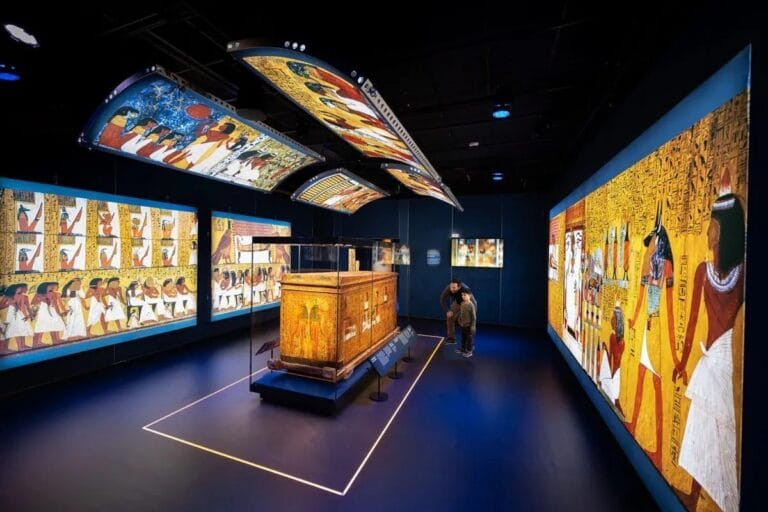- Air transport of fine art and museum artefacts is a highly specialised, multi-billion-dollar logistics sector that combines bespoke packaging, climate control, GPS tracking, and often armed courier escorts to protect priceless objects during international transit
- Operational risks include damage in transit, regulatory and customs complexity, airport access limits, and theft, requiring meticulous project management, condition reporting, and coordination with conservators and museum registrars
- Companies like EFM handle large-scale exhibitions such as the Ramses & the Gold of the Pharaohs tour, moving artefacts, set-works, and merchandise by dedicated charter aircraft with armed security, bespoke crates, and full end-to-end monitoring to ensure safe and timely delivery across multiple continents
In the 1960s, a British artist based in Malta was said to be shipping an artwork back to London. On arrival at Valetta airport, he was told it was too big to load. Taking out a saw, he is said to have cut it in half, saying it could be reassembled on arrival. This unlikely tale reflects how much such art transport has changed in the last sixty years.
Moving priceless artworks between museum locations by air is a niche but fast-growing segment of global logistics that combines high-value insurance, bespoke packaging, climate control and diplomatic customs work. Modern fine-art air logistics requires bespoke crates, vibration-damped palletisation, active environmental monitoring (temp/humidity/light), GPS tracking and often an institutional and possibly armed courier escort to reduce risk during origin/destination handling and customs.
The sector’s commercial scale is measured in billions: recent market reports place the global fine-art/fine-arts logistics market in the low-to-mid single-digit billions ($2.9–3.4 billion) in the mid-2020s) with multi-percent CAGR forecasts into the 2030s as museum touring, fairs and cross-border sales expand. That steady growth reflects rising online sales, more international exhibitions and demand for climate-controlled storage and transport.
Practical challenges are many. Damage during transit remains the dominant operational risk – specialist insurers report that around half of insured losses arise from accidental damage in transit – so rigorous packaging, specialist handling and pre- and post-transit condition reporting are essentials. Regulatory and customs complexity, such as temporary export licences, cultural property checks, airport access limits for oversized pieces and co-ordinating installation windows with host museums add layers of project management. Security, such as theft risk carbon footprint of air movements and rapidly rising freight/charter costs further complicate planning and budgeting.
Who provides these services? There is a well-established ecosystem of specialist forwarders and art-logistics providers – names you will commonly see include Crown Fine Art, Cadogan Tate, Momart, Gander & White, Dietl, Convelio and numerous regional specialists – alongside mainstream forwarders with fine-art divisions. Industry networks and associations (e.g., IELA [International Exhibition Logistics Association], ICEFAT [International Convention of Exhibition and Fine Art Transporters]) aggregate dozens to over a hundred accredited members worldwide, showing the market’s breadth even if an exact total of “forwarders offering art-specialist airfreight” is fluid and hard to pin to a single number.
In short: museum air logistics is specialised, costly and risk-heavy but professionally mature – a multi-billion-dollar niche served by a few dozen global specialists and many more regional players co-ordinated through industry networks.
In the shadow of the Pharaohs
Egham, UK-based EFM is one such company that handles special cargo relating to museum logistics. It was recently appointed by a major touring exhibition organiser to manage the complete logistics of one of the most challenging moves in the exhibition industry.
The blockbuster touring exhibition from Egypt, Ramses & the Gold of the Pharaohs exhibition, consists of priceless artefacts dated 3,500 years ago. A multisensory exhibition showcasing 181 objects exploring the life and accomplishments of Ramses II which opened in Tokyo, Japan in the Spring of 2025. Many of the artefacts have never before been seen outside of Egypt. Also known as Ramses the Great, he was one of the most prolific builders ancient Egypt. Responsible for the extraordinary temples at Abu Simbel in the south, to the Ramesseum in Luxor and Pi-Ramesses in the Nile Delta to the North. Ramses left his mark on buildings across Egypt and Nubia like no other Egyptian monarch.
Besides exceptional artefacts associated the king himself, including exquisite golden treasures from his tomb, the exhibition also includes sarcophaguses, animal mummies, jewellery, royal masks, amulets of other individuals, such as his mother, his wife. This collection of extraordinary objects is a testament to the workmanship of ancient Egyptian craftspeople.
Additionally, the exhibition included around 25 truckloads of scenic set-works and merchandising.
From Europe to Asia
EFM had just four weeks to move the whole exhibition on the final legs of its world tour from Cologne, Germany, to Tokyo, Japan, for reinstallation; no easy feat.
Artefacts, set-works and merchandise were split into three major operations. Moving priceless artefacts required security, and external armed security was hired to accompany every leg of the artefact move.
The artefacts were moved by a dedicated chartered aircraft and accompanied by armed convoys at each point. EFM also provided full courier assistance to the Ministry of Culture representative.
The end-to-end approach to care allowed EFM to have 30 people monitoring the move, with everything being recorded. The company also shipped 25 truck equivalent loads of Set-works and merchandise by air to meet the deadline. EFM found an extremely cost-effective option while also flying to the airport to build airline pallets to ensure items didn’t go missing or get damaged.
EFM continue to retain the tour and have covered Houston – San Francisco, San Francisco – Paris, Paris – Sydney, Sydney – Cologne and Japan with London upcoming in 2026.
Packing is the foundation of the entire shipping strategy
According to EFM, in fine art logistics and museum artefact shipping, every crate must be engineered for the specific object it holds, taking into account fragility, materials, climate sensitivity and travel distance. The packing plan must hold up under customs inspections, climate changes, vibration, and sometimes, weeks in transit.
Secure transit begins with the crate. Poor packing undermines even the best logistics partners and climate controls, so every shipment starts with an assessment of the object’s material, condition, size, and route. Textiles, bronzes and paintings all demand different solutions.
EFM collaborates with registrars and conservators to design bespoke cases, integrating vibration absorption, thermal insulation, humidity control, and modular supports. Each layer of packing – foams, acid-free wraps, sensors and indicators – has a defined role in protection, monitoring, or stabilisation. Fit tests, loading trials, and destination unpacking reviews ensure the solution works in practice; fragile or high-value pieces often require mock-ups for approval.
Close co-ordination is essential. Conservators and couriers help define handling protocols and monitor crates through transfers and delivery. For fine art, the crate is both mobile environment and first defence. EFM’s integrated packing strategy safeguards works from departure to installation, says the company.





